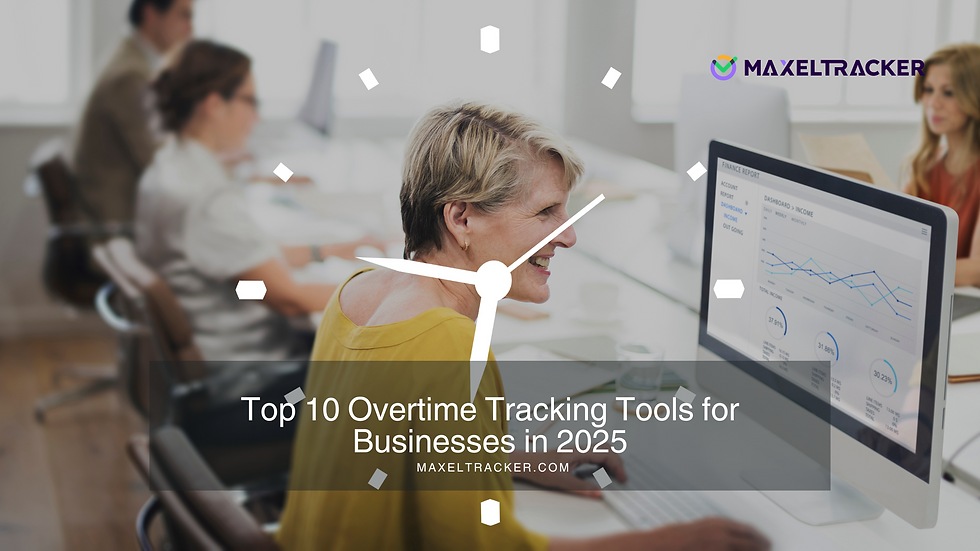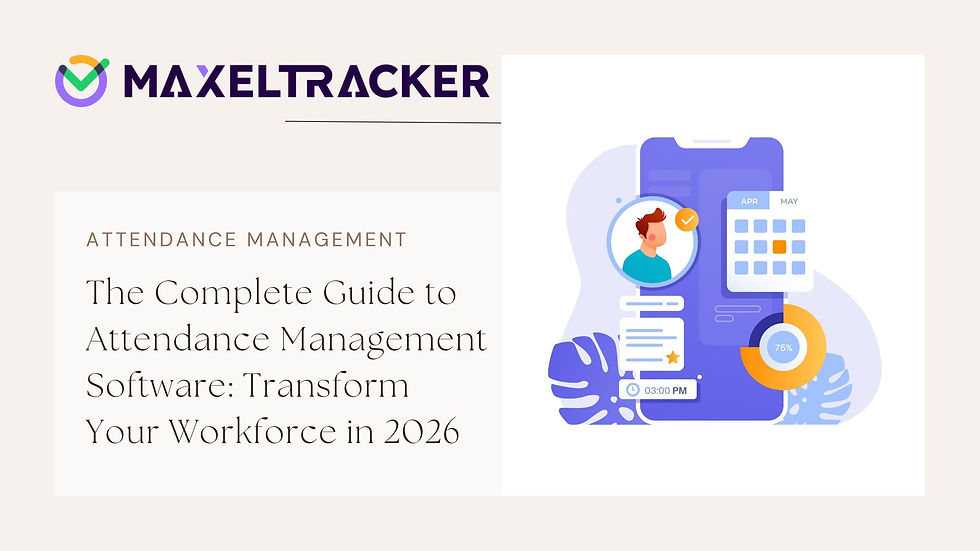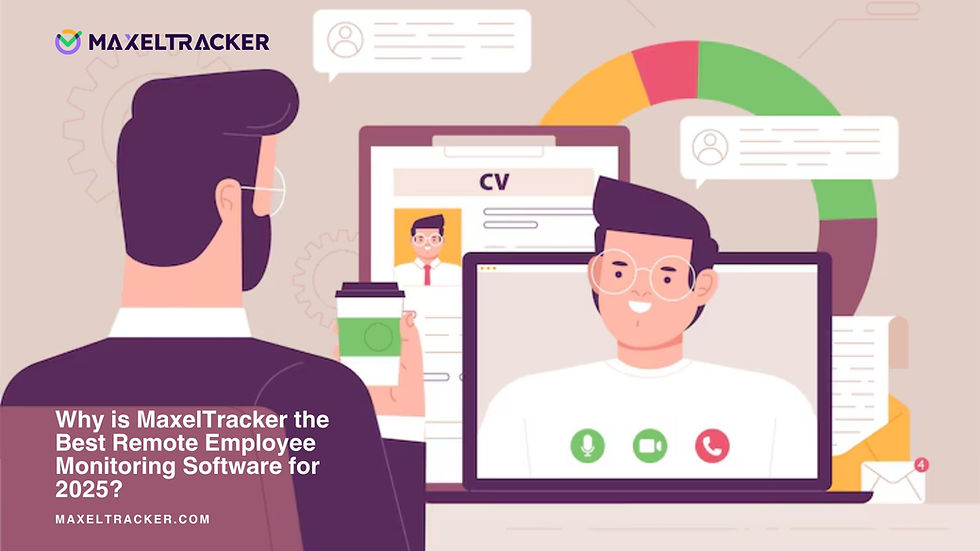Top 10 Overtime Tracking Tools for Businesses in 2025
- maxeltracker
- Jul 8
- 11 min read

Keeping track of employee overtime can be challenging, especially when managing large teams or juggling multiple shifts across remote, hybrid, or in-office environments. Without the right tools, it’s easy for overtime hours to go unnoticed, leading to payroll errors, burnout, and compliance risks. That’s why reliable overtime tracking tools are essential for maintaining transparency and accuracy in how extra hours are recorded and compensated.
In this article, we explore a range of top overtime tracking solutions available today. We break down their core features, highlight the benefits and limitations of each, and provide pricing details to help you compare. Whether you're managing a small team or a large workforce, this handpicked list of the 10 best overtime tracking tools will help you choose a solution that fits your organization’s specific needs.
What is an Overtime Tracking Software?
Overtime tracking software is designed to monitor and record the extra hours employees work beyond their scheduled shifts. These tools provide real-time visibility into overtime patterns, helping managers ensure compliance with labor laws, prevent employee fatigue, and maintain accurate payroll processing. By automatically capturing work hours and flagging overtime, businesses can stay on top of workforce costs and avoid manual errors.
Common features of overtime tracking software include:
Automated time logging for regular and overtime hours
Customizable overtime rules based on company policies or regional labor laws
Alerts for excessive overtime or policy violations
Detailed reports for payroll and compliance audits
Integration with HR and payroll systems
By using overtime tracking software, businesses can manage workloads more effectively, ensure fair compensation, reduce burnout, and make data-driven decisions that support both productivity and employee well-being.
Why Should You Use Overtime Tracking Software?
Tracking overtime manually can be time-consuming, error-prone, and difficult to manage, especially when teams grow or work across different shifts. Overtime tracking software helps businesses stay organized, avoid compliance issues, and ensure that employees are not overworked or underpaid. It brings structure, clarity, and control to how extra work hours are monitored and managed.

Here are the key benefits of using overtime tracking software:
1. Accurate Time and Payroll Management
Overtime tracking software automatically records extra hours worked, reducing errors in manual timesheets and ensuring employees are fairly compensated. This helps finance teams process payroll more accurately and avoid disputes over unpaid overtime.
2. Helps You Stay Compliant with Labor Laws
Different regions have specific rules about how much overtime employees can work and how it should be paid. Overtime tracking tools help businesses follow these laws by applying custom rules, sending alerts for violations, and keeping proper records for audits or legal reviews.
3. Improved Workload Balance
Consistently working overtime can lead to stress, fatigue, and decreased productivity. With Overtime tracking software, managers can identify patterns of overwork and take action, such as redistributing tasks or adjusting schedules, before burnout becomes a serious issue.
4. Improves Transparency and Accountability
With clear records of worked hours, both managers and employees know where time is being spent. Employees can view their logged hours, and managers get a real-time overview of overtime across the team. This builds trust and ensures everyone is on the same page.
5. Supports Better Workforce Planning
By analyzing overtime trends, you can identify whether your team is understaffed or if certain roles consistently require extra hours. This insight helps you make informed decisions about hiring, shift planning, or improving internal processes.
Top 10 Overtime Tracking Software of 2025
With so many tools available today, choosing the right overtime tracking software can feel overwhelming. Each solution offers different features, pricing, and benefits, so it's important to find one that fits your team’s size, work style, and business goals.

To make your search easier, we’ve put together a list of the top overtime tracking tools of 2025. These tools help businesses track extra hours accurately, stay compliant with labor laws, avoid payroll mistakes, and prevent employee burnout.
Explore the list below to find the right fit for your company’s overtime management needs.
MaxelTracker
MaxelTracker is a comprehensive overtime tracking software designed to give organizations clear insights into employee work hours and overtime without micromanagement. It helps HR teams and managers monitor overtime trends, analyze productivity, and manage workforce schedules efficiently. MaxelTracker’s robust reporting and real-time monitoring allow companies to spot overtime early, supporting better workload distribution and preventing burnout.
Get deeper insights about how maxeltracker helpful in boosting prodyctivity:
Key Features:
Automated overtime detection with real-time alerts
Detailed time logs and activity reports
Geo-location tracking to verify clock-in locations
Role-based access for secure and customized data viewing
Smart screenshots and app categorization for productivity insights
Integration with popular tools like Slack, Trello, and Keka
Department-wise overtime analysis and reporting
Pros:
Real-time overtime alerts help prevent overwork and support employee well-being
Detailed reports assist HR in managing overtime costs and compliance
Role-based controls ensure privacy and data security
Works well for remote, hybrid, and office teams
Easy integration with existing workflows and tools
Cons:
No built-in payroll processing integration
Mobile app functionality is limited compared to desktop
Initial setup and customization can take time for large teams
Pricing:
Free 14-day trial available with full features
Pro Plan: $1.99/user/month with unlimited users and reports
Enterprise Plan: Custom pricing for large organizations with advanced support
Clockify
Clockify is a time and overtime tracking tool that's especially useful for freelancers, small teams, and growing businesses. It allows users to track work hours by project, helping managers get a better understanding of how time is spent and when employees go into overtime.
With Clockify, users can log hours manually, use a shared kiosk, or track time via the mobile app. Managers can filter timesheets to identify who has worked overtime and how often, making it easier to manage workloads and payroll.
However, while Clockify helps you monitor overtime, it lacks certain advanced controls like GPS tracking and overtime prevention alerts—features that are typically found in more enterprise-focused solutions.
Key Features:
Time tracking by task and project
Overtime visibility via filtered timesheets
Team scheduling and workflow management
Billable hours tracking with invoicing tools
Pros:
Affordable pricing with a free plan
Clean, intuitive interface
Works well for remote and mobile teams
Cons:
No GPS tracking to verify where employees clock in
Doesn’t offer proactive overtime prevention features
Pricing:
Basic Plan: Starts at $3.99/user/month
Free Plan: Available with essential time tracking features
Trial: Free trial available for PRO features
Timely
Timely is an AI-powered time-tracking tool that automates the process of logging work hours, helping teams manage time more efficiently and avoid excessive overtime. It’s designed for desk-based teams that rely on digital tools, offering smart integrations and real-time tracking to ensure projects stay on budget and on schedule.
By automatically recording time spent across different apps and tasks, Timely helps managers get a clear breakdown of how work hours are distributed, making it easier to spot trends in overtime before they become a problem. It also supports project planning and budgeting, giving employers the insight needed to balance workloads more effectively.
However, Timely may not be the best fit for deskless workers, such as field employees or those in non-digital roles, as it relies on desktop activity tracking. It also lacks built-in invoicing or billing features, which some businesses may find limiting.
Key Features:
Automatic time tracking
Real-time project monitoring
Budget and workload management
Detailed time usage reports
Pros:
User-friendly interface
Reduces manual logging
Helpful for spotting and managing overtime
Cons:
Not ideal for non-desk workers
No integrated billing or invoicing tools
Pricing:
Starts at $16/user/month for teams of 6–50 users
Free trial available
No free plan
TimeCamp
TimeCamp is a time and overtime tracking tool designed to help teams manage their hours efficiently. It automatically tracks employee time, including overtime, and lets users manually adjust or add entries when needed. With built-in features for tracking billable vs. non-billable hours, TimeCamp makes it easy for managers to monitor how much time employees are spending on projects—and when they’re crossing into overtime.
TimeCamp also offers productivity tracking and real-time dashboards, giving managers full visibility into work hours and overtime patterns. It integrates well with a variety of tools, including project management, sales, marketing, and accounting platforms, making it a great option for both small and large teams.
Key Features:
Automatic time and attendance tracking
Overtime monitoring with manual adjustments
Real-time dashboards and productivity tracking
Tracking of billable and non-billable hours
Invoicing tools for client billing
Pros:
Offers clear visibility into project hours and overtime
Simple to use with flexible manual and automatic tracking
Supports mobile access for time tracking on the go
Integrates with many third-party tools
Cons:
The interface may feel slow or cluttered at times
Setting up rules for automatic tracking can be time-consuming
Mobile version lacks some desktop functionality
Pricing:
Starter Plan: $2.99/user/month (billed annually) – Time & Billing
Premium Plan: $4.99/user/month – Profit & Productivity
Ultimate Plan: $7.99/user/month – Analytics & Collaboration
Enterprise Plan: $11.99/user/month – Management & Security
Free Plan: Available (with limited features)
Time Doctor
Time Doctor is a cloud-based time and productivity tracking tool that’s well-suited for monitoring overtime hours across teams, whether they’re remote, hybrid, or in-office. With real-time tracking and in-depth analytics, Time Doctor helps managers see exactly how much time employees spend on tasks and when those hours go into overtime.
The platform starts tracking as soon as an employee begins a task and continues even when offline, ensuring accurate records of total work time. Managers can use this data to track overtime trends, manage workloads more effectively, and make informed decisions about scheduling and compensation.
Key Features:
Automatic time tracking that starts with task initiation
Offline tracking for complete activity records
Work schedules and attendance monitoring
Timeline reports to visualize daily activities and overtime
Time usage alerts and distraction management tools
Payroll integration for easy overtime payouts
Pros:
Includes silent mode, which auto-tracks time without interrupting employees
Idle tracking detects inactivity and helps ensure overtime logs are accurate
Built-in payroll system that supports overtime pay calculations
Available as a mobile app for iOS and Android
Cons:
The user interface can be a bit complex for new users
Time syncing may be inconsistent across multiple devices
Pricing:
Basic Plan: $5.90/user/month (billed annually)
Standard Plan: $8.40/user/month (billed annually)
Premium Plan: $16.70/user/month (billed annually)
Free Trial: Available for all plans
Hubstaff
Hubstaff is a powerful overtime tracking software designed for teams that need clear visibility into working hours, attendance, and overtime. Whether your employees work remotely, in the field, or the office, Hubstaff helps managers monitor work time without micromanaging.
Its automated timesheets and built-in overtime tracker make it easier to manage workloads and ensure employees are fairly compensated for extra hours. With GPS tracking, Hubstaff is also ideal for businesses with mobile or remote teams.
Key Features:
Automated timesheets for accurate hour tracking
Overtime tracking to monitor extra work hours
Geofencing to verify employee location on the job
In-app payments and payroll based on tracked time
Detailed productivity reports and attendance tracking
Add-on for insights to track app usage and set benchmarks
Pros:
Supports scheduled work hours and alerts when employees go into overtime
Easy to use for remote, field, and in-office teams
Offers self-managed tools like habit tracking to reduce overworking
Can be integrated with HR and task management tools
Cons:
Some reports don’t display exact time in decimals, which can reduce accuracy
Customization options are limited in some features
Advanced tracking tools are only available on higher-tier plans
Pricing:
Starter Plan: $4.99/user/month (billed annually)
Grow Plan: $7.50/user/month (billed annually)
Team Plan: $10/user/month (billed annually)
Enterprise Plan: $25/user/month (billed annually)
Free Trial: Available
Harvest
Harvest is a time tracking software that works well for businesses managing multiple projects simultaneously, especially client service teams. It helps track work hours and project expenses, including overtime. Along with overtime tracking, Harvest enables users to monitor costs such as materials, travel, and supplies. It also supports reporting on billable hours, creating invoices, and collecting payments, making it easy to manage project budgets. Harvest connects with popular tools such as Slack and Asana, so time tracking fits smoothly into your team’s existing workflow. However, it doesn’t offer direct payroll integrations, so managers need to handle payroll separately.
While Harvest tracks overtime, it lacks advanced features to help managers prevent overtime or build work schedules that avoid it.
Key Features:
Time and overtime tracking
Project-specific tracking and expense management
Reporting and analytics for work hours and costs
Invoicing and payment collection
Pros:
Integrates with popular task management tools
Supports time-based billing for accurate client invoicing
Cons:
No payroll integration for automatic payroll processing
Lacks tools to prevent or manage overtime proactively
Pricing:
$10.80 per user/month
30-day free trial available
Free plan available for 1 user and 2 projects
Desklog
Desklog is a robust overtime tracking software designed to help teams manage work hours more effectively while improving productivity. With automated time tracking, it eliminates the need for manual entries and provides accurate records of employee hours, including overtime. Real-time monitoring and detailed reports give managers clear visibility into workforce performance and help identify when employees exceed their scheduled hours.
Perfect for project management, Desklog lets users assign tasks, set deadlines, and track both billable and non-billable hours. This makes it easier to estimate project costs and manage schedules to avoid excessive overtime. Additionally, Desklog supports healthy work habits by reducing distractions and encouraging focused work sessions.
Desklog also includes attendance and leave management tools that help prevent burnout by promoting work-life balance. Its flexible billing features ensure accurate invoicing based on actual hours worked, including overtime.
Key Features:
Automated time and overtime tracking for unlimited users and projects
Task and project timesheets
Idle time and efficiency monitoring
Billing and invoicing based on tracked hours
Detailed reports and task commenting
Project profit and loss calculator
Integrations with Jira
App and URL tracking
Activity percentage analysis
Pros:
Supports unlimited users and projects with no restrictions
Accurate overtime tracking with real-time visibility
Helps improve focus and reduce workplace distractions
Offers comprehensive project cost and billing management
Biometric integration enhances attendance accuracy
Cons:
Interface may be overwhelming for first-time users
Some advanced features require a higher-tier plan
Limited offline capabilities
Pricing:
Starter Plan: $2.99 per user/month (billed annually) — includes basic time and overtime tracking
Pro Plan: $5.99 per user/month (billed annually) — adds advanced reporting, billing, and integrations
Enterprise Plan: Custom pricing — offers biometric integration, premium support, and personalized onboarding
Toggle Track
Toggl Track is a user-friendly overtime tracking software that helps businesses monitor employee work hours and identify overtime with ease. It provides flexible time-tracking features that allow users to start and stop timers across multiple devices, making it simple to log actual hours worked. Managers can use Toggl Track’s reporting tools to see who is working overtime and analyze work patterns to improve scheduling.
Key Features:
Simple, one-click time tracking across devices
Customizable reports highlighting overtime hours
Project and client tracking for accurate overtime billing
Idle detection to ensure precise time logs
Team dashboard with real-time activity monitoring
Pros:
Intuitive and easy to use for employees and managers
Powerful reporting tools to identify and manage overtime
Integrates with over 100 popular apps for streamlined workflows
Offers mobile and desktop apps for flexibility
Cons:
Overtime alerts and automation are limited compared to specialized tools
No built-in payroll or advanced overtime prevention features
Pricing:
Free plan available with basic time tracking
Starter Plan: $10/user/month (billed annually)
Premium Plan: $20/user/month (billed annually), includes advanced reporting and project tracking
Enterprise Plan: Custom pricing with enhanced security and support
Clockify
Clockify is a popular overtime tracking software designed for freelancers and teams who want straightforward time and overtime tracking without complexity. It allows employees to clock in and out manually or via apps, and managers can easily filter timesheets to spot overtime hours. Clockify’s project-based tracking also helps businesses allocate overtime costs accurately.
Key Features:
Manual and automatic time tracking
Detailed timesheets with overtime filtering
Project and task time allocation
Reports that show billable vs. non-billable and overtime hours
Mobile, desktop, and browser app support
Pros:
Free plan with unlimited users and projects
Easy to use with a clean interface
Budget-friendly for small businesses and freelancers
Flexible manual timesheet editing
Cons:
Lacks advanced overtime prevention or scheduling tools
No GPS tracking for location-based overtime monitoring
Limited control over where employees clock in/out
Pricing:
Free plan with core time and overtime tracking features
Basic Plan: $3.99/user/month (billed annually)
Standard Plan: $6.99/user/month (billed annually)
Pro Plan: $9.99/user/month (billed annually) with advanced reporting and integrations
Conclusion
Overtime doesn’t have to drain your budget or disrupt your workflow. With the right software in place, managing extra hours becomes a clear and structured process. MaxelTracker stands out with intelligent overtime tracking, real-time data, and detailed reporting tools that give you full visibility into team hours. Designed to support efficiency without overwork, it helps you maintain compliance, reduce unnecessary labor costs, and protect employee well-being.
In short, if you're looking for a reliable, cost-effective way to manage overtime and keep your team on track, MaxelTracker is the tool to trust.
Also, explore more from Maxeltracker
https://www.maxeltracker.com/blog/strategies-to-manage-remote-employees
https://www.maxeltracker.com/blog/reasons-why-companies-should-adopt-hybrid-working
https://maxeltracker.tumblr.com/post/779603724689719296/best-remote-employee-monitoring-software-for
https://dev.to/colinbrown262/how-an-employee-monitoring-system-can-improve-business-efficiency-14pm
https://colinbrownofficial.medium.com/top-11-employee-monitoring-tools-in-india-9bbfb524c6d4
https://maxeltracker.hashnode.dev/what-is-the-best-employee-monitoring-software-and-how-does-it-work



Comments